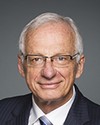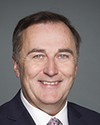I'll lead in responding to that question.
Certainly, as I mentioned earlier, we only know one in five of our younger veterans, those who have served from 1999 onwards. Yes, we only know one in five.
So we rely on our ex-service organization community, veterans' service organizations which are non-government organizations, to connect with those younger veterans to bring them into the mainstream, to help ensure that they're receiving the support and services that they're eligible for through the Department of Veterans' Affairs.
We have, I think, about 3,000 ex-service organizations, with a lot of them registered as charities. Sometimes they are not as helpful as they could be, but where they are helpful and work with the department, we try to reach those veterans. Certainly we did, as I mentioned, from 12 months ago...we refer to it as “closing the door”. So we now know everyone who enlists in the Australian Defence Force, and through the transformation work that Kate Pope is leading, we're identifying ways we can reach out so that we can connect with those who aren't aware of the support and services we have available.
One other thing that we have done is work with our Commonwealth Superannuation Corporation and data analysts to do some geospatial mapping to work out where those younger veterans are, when they've transitioned from the ADF, where have they gone to live, so that we can see what is available to them in those remote communities, in a lot of instances, across Australia. A range of efforts are under way to try to connect with them.




